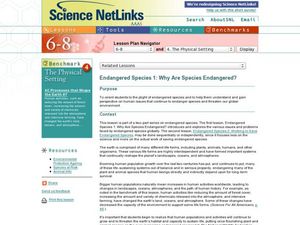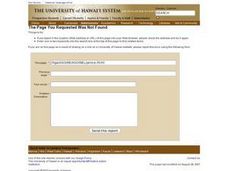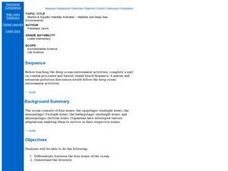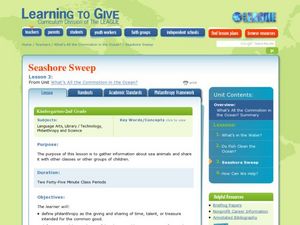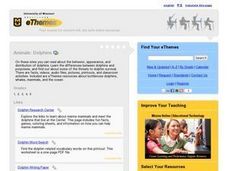Alabama Learning Exchange
The Ocean Floor
Learners explore the ocean in this earth science lesson. They use the Internet to gather information on parts of the ocean including the beach, ocean floor, continental shelf, trenches, and the animals that inhabit these parts.
Curated OER
Marine Animal and Plant Adaptations
Young scholars examine nature by creating their own animals. For this animal adaptation lesson, students define scientific vocabulary terms dealing with adaptation such as sea stars, sea cucumbers and exoskeleton. Young scholars utilize...
Curated OER
Ocean Exploration: Shapes and Patterns Under the Sea
So many shapes in our vast oceans. Young explorers can discover new shapes in a variety of ways in this lesson. One way is having free exploration with a pattern shape kit handed out by the teacher. Another is by viewing a video, Ocean...
Curated OER
Specialized for the Sea
Students use pictures and make a mural to investigate how ocean animals are adapted to certain parts of their environment.
Curated OER
Endangered Species 1: Why are Species Endangered?
Emerging ecologists examine endangered species by visiting the US Environmental Protection Agency website. They consider human contribution to the decline of different species. They research an endangered animal and then craft a poster...
Curated OER
Pets Around the World
Learners communicate via e-mail with other students to learn about pets, animals of interest , and geography from different parts of the world. Vocabulary focuses on rural, urban, and suburban areas.
Curated OER
Home Sweet Home
Students explore marine turtle habitats. Students research one species of marine turtle found in the Gulf of Mexico. They identify plants and animals in the habitat. They create a model or replica using information gathered through their...
Curated OER
Spineless - YES... Helpless - NO!
Students distinguish between invertebrate and vertebrate organisms while examining the zoological classes of a number of invertebrates. They illustrate a food web of these organisms and investigate the impact of humans on the oceanic...
Curated OER
Out of the Deep
Learners observe, describe, and record characteristics of ocean animals (mammals and fish) and sea shells. They conduct an experiment comparing and contrasting sugar water, salt water and fresh water and create a mural of coral reef...
Curated OER
Ocean/Beach Center
Students examine different types of ocean life. They classify sea shells and role play in the ocean center. They color and write about their experience in the ocean center and share their experiences with their classmates.
Curated OER
Habitats and Deep Sea Environments
Students examine and identify the characteristics of the four zones of the ocean. They discover the amount of diversity in marine habitats. They also explore the adaptations organisms have that have allowed them to survive.
Curated OER
The Magic School Bus Explores the Ocean
Students are introduced to "The Magic School Bus Explores the Ocean". They should have been studying the ocean. They have heard and read many books on the topic. This software will bring the ocean to life and provide information to...
Curated OER
Explorit's SEASHORE Quiz
In this online interactive seashore quiz worksheet, students respond to 5 multiple choice questions. Students may check their answers for accuracy.
Curated OER
Do Fish Clean the Ocean?
Students analyze a reading selection. In this ocean lesson, students read a story about the ocean, ocean animals and coral reefs. Students have the option to complete internet research on coral reefs. Students write in their journals...
Curated OER
Seashore Sweep
Young scholars gather information about sea animals. For this ocean lesson, students read a story about the ocean and seashore. They discuss the needs of seashore animals and create a Mystery Ocean Animal riddle book. Young scholars...
Curated OER
Animals: Dolphins
Students use the internet to discover information about dolphins. They examine their behavior, appearance and distribution of dolphins.
Curated OER
Blue Planet: Seas of Life
Learners study coral reefs and marine communities. In this investigative lesson students get into groups and are assigned a subject. In their groups they create a poster about their assigned topic.
Curated OER
Seas Of Life
Students brainstorm examples of predator and prey that are featured in a video they watch. In this investigative lesson plan students will research an animal from the video and explain if it is a predator or prey and how it helps...
Curated OER
Should We Hunt the Largest Animals on the Planet?
Young scholars discover details about whaling. In this environmental stewardship lesson, students research selected websites to locate information about commercial whaling and its implications.
American Museum of Natural History
What do You Know About Life on Earth?
Humans have only inhabited the earth for a fraction of the time that life has existed. Young scientists explore the facts about the emergence of life on Earth with an interactive resource. While highlighting different types of life, the...
University of Southern California
What Lives In The Ocean?
One of the most diverse environments on Earth is the ocean. Young scientists explore the living things found in the ocean during an exciting seven-lesson unit. Their study includes organisms from plankton to invertebrates and vertebrates...
Curated OER
Scavenger Hunt: Home Sweet Habitat
In this animal habitat worksheet, students participate in a scavenger hunt that involves an in-depth study of animal habitats and then correlates that concept to the student's own personal habitat's.
American Museum of Natural History
Dive Into Worlds Within the Sea
The ocean is a series of ecosystems within an ecosystem. Learners dive into an exploration of ecosystems in an interactive lesson. They identify connections between organisms by following leading prompts within the lesson. The resource...
American Museum of Natural History
Crazy Camouflage
Scholars discover the crazy camouflage technique of the flounder fish. After reading three informative paragraphs, participants follow steps to make a model of the sea creature.






